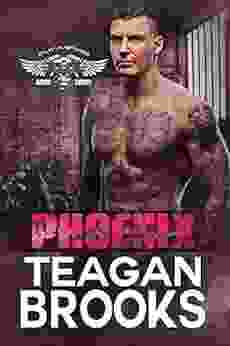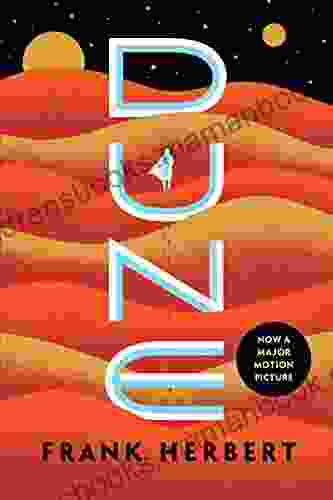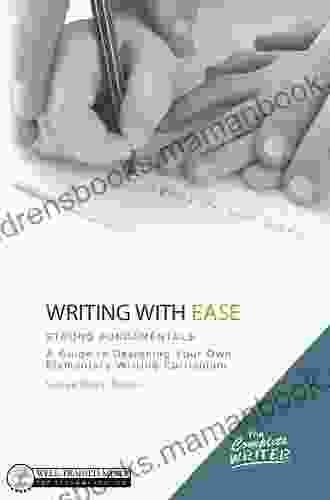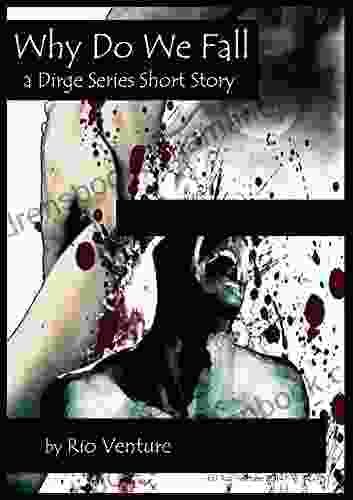A Comprehensive Guide to Designing Your Own Elementary Writing Curriculum: The Complete Writer

Writing is a fundamental skill that empowers students to express themselves, communicate their ideas, and learn about the world around them. As an elementary teacher, you have the incredible opportunity to lay the foundation for your students' writing abilities and inspire them to become confident and effective communicators. Designing your own writing curriculum allows you to tailor instruction to the specific needs of your students and create a learning environment that fosters their growth as writers.
4.7 out of 5
| Language | : | English |
| File size | : | 1149 KB |
| Text-to-Speech | : | Enabled |
| Enhanced typesetting | : | Enabled |
| Print length | : | 275 pages |
| Screen Reader | : | Supported |
This comprehensive guide will provide you with all the essential information and resources you need to develop a writing curriculum that nurtures your students' creativity and equips them with the essential skills to become effective communicators. We will cover the following key areas:
- Understanding the Writing Process
- Developing Writing Skills
- Creating a Writing Workshop
- Assessment and Feedback
- Resources and Activities
Understanding the Writing Process
The writing process is a series of steps that writers go through to create a piece of writing. These steps include:
- Prewriting: This stage involves generating ideas, brainstorming, and planning your writing.
- Drafting: This is where you write the first version of your piece.
- Revising: This stage involves making changes to your draft to improve its clarity, organization, and flow.
- Editing: This is where you correct any errors in grammar, spelling, and punctuation.
- Publishing: This is the final stage where you share your writing with others.
Understanding the writing process is essential for teachers because it helps them to guide students through the different stages of writing and provide them with the necessary support and feedback at each stage.
Developing Writing Skills
There are a number of key writing skills that students need to develop in order to become effective communicators. These skills include:
- Planning and Organization: Students need to be able to plan and organize their writing in a logical and cohesive way.
- Sentence Structure: Students need to be able to write clear and concise sentences.
- Vocabulary: Students need to have a wide vocabulary to express themselves clearly and effectively.
- Grammar and Usage: Students need to be able to use correct grammar and usage in their writing.
- Mechanics: Students need to be able to use correct spelling, punctuation, and capitalization.
There are a variety of ways to help students develop these writing skills. Some effective strategies include:
- Providing explicit instruction on the writing process and writing skills.
- Giving students opportunities to practice writing in a variety of genres and formats.
- Providing feedback on student writing and helping them to identify areas for improvement.
Creating a Writing Workshop
A writing workshop is a structured approach to teaching writing that provides students with opportunities to write, share their writing, and receive feedback from their peers and teacher. Writing workshops are an effective way to help students develop their writing skills and foster their love of writing.
To create a writing workshop, you will need to:
- Establish a regular time and place for the workshop.
- Create a positive and supportive learning environment.
- Provide students with clear expectations and guidelines for writing.
- Facilitate writing activities and discussions.
- Provide feedback on student writing.
Assessment and Feedback
Assessment is an essential part of the writing process. It helps teachers to track student progress, identify areas for improvement, and provide students with the feedback they need to grow as writers.
There are a variety of ways to assess student writing. Some common methods include:
- Portfolios: Portfolios are a collection of student writing that can be used to assess student progress over time.
- Rubrics: Rubrics are scoring guides that can be used to assess specific writing skills.
- Checklists: Checklists are lists of criteria that can be used to assess writing.
Feedback is an essential part of the writing process. It helps students to understand their strengths and weaknesses as writers and provides them with specific suggestions for improvement.
When providing feedback on student writing, it is important to be:
- Specific: Provide specific feedback on the writing that includes both strengths and areas for improvement.
- Actionable: Provide feedback that students can use to improve their writing.
- Positive: Focus on the positive aspects of the writing and provide encouragement.
- Timely: Provide feedback as soon as possible so that students can use it to inform their writing.
Resources and Activities
There are a variety of resources and activities that you can use to support your writing instruction. Some helpful resources include:
- Writing websites and blogs
- Writing apps
- Writing games
- Writing workshops
- Writing conferences
Here are some engaging activities that you can use to help students develop their writing skills:
- Freewriting: Freewriting is a timed writing exercise where students write whatever comes to mind without stopping.
- Word sprints: Word sprints are timed writing exercises where students write as many words as they can in a given amount of time.
- Story starters: Story starters are short prompts that students can use to generate ideas for writing stories.
- Peer editing: Peer editing is an activity where students share their writing with each other and provide feedback.
- Writing conferences: Writing conferences are one-on-one meetings between students and their teacher to discuss their writing.
Designing your own elementary writing curriculum is a rewarding experience that allows you to tailor instruction to the specific needs of your students. By following the steps outlined in this guide, you can create a writing curriculum that nurtures your students' creativity and equips them with the essential skills to become effective communicators.
Remember, the most important thing is to create a learning environment that is positive and supportive and that fosters your students' love of writing. With careful planning and implementation, your writing curriculum will be a success!
4.7 out of 5
| Language | : | English |
| File size | : | 1149 KB |
| Text-to-Speech | : | Enabled |
| Enhanced typesetting | : | Enabled |
| Print length | : | 275 pages |
| Screen Reader | : | Supported |
Do you want to contribute by writing guest posts on this blog?
Please contact us and send us a resume of previous articles that you have written.
 Top Book
Top Book Novel
Novel Fiction
Fiction Nonfiction
Nonfiction Literature
Literature Paperback
Paperback Hardcover
Hardcover E-book
E-book Audiobook
Audiobook Bestseller
Bestseller Classic
Classic Mystery
Mystery Thriller
Thriller Romance
Romance Fantasy
Fantasy Science Fiction
Science Fiction Biography
Biography Memoir
Memoir Autobiography
Autobiography Poetry
Poetry Drama
Drama Historical Fiction
Historical Fiction Self-help
Self-help Young Adult
Young Adult Childrens Books
Childrens Books Graphic Novel
Graphic Novel Anthology
Anthology Series
Series Encyclopedia
Encyclopedia Reference
Reference Guidebook
Guidebook Textbook
Textbook Workbook
Workbook Journal
Journal Diary
Diary Manuscript
Manuscript Folio
Folio Pulp Fiction
Pulp Fiction Short Stories
Short Stories Fairy Tales
Fairy Tales Fables
Fables Mythology
Mythology Philosophy
Philosophy Religion
Religion Spirituality
Spirituality Essays
Essays Critique
Critique Commentary
Commentary Glossary
Glossary Bibliography
Bibliography Index
Index Table of Contents
Table of Contents Preface
Preface Introduction
Introduction Foreword
Foreword Afterword
Afterword Appendices
Appendices Annotations
Annotations Footnotes
Footnotes Epilogue
Epilogue Prologue
Prologue Andy Husbands
Andy Husbands Mark Bray
Mark Bray Jessie Sheehan
Jessie Sheehan Mel Brooks
Mel Brooks Naomi Pomeroy
Naomi Pomeroy Marian Small
Marian Small Galin H
Galin H Cree Nations
Cree Nations Suzanne Ferriss
Suzanne Ferriss Janet Lynne Jackson
Janet Lynne Jackson Dr Rupy Aujla
Dr Rupy Aujla Ellen Jovin
Ellen Jovin Antonio Tabucchi
Antonio Tabucchi Lewis Hill
Lewis Hill Alison Edwards
Alison Edwards Steven Rinella
Steven Rinella Cat Sebastian
Cat Sebastian Allan W Eckert
Allan W Eckert Chris De Feyter
Chris De Feyter Amy Medling
Amy Medling
Light bulbAdvertise smarter! Our strategic ad space ensures maximum exposure. Reserve your spot today!

 Francis TurnerLady Lace Vest Crochet Pattern 119: A Masterpiece of Delicate Craftsmanship
Francis TurnerLady Lace Vest Crochet Pattern 119: A Masterpiece of Delicate Craftsmanship
 Oliver FosterPhoenix Blackwings Mc: Unveiling the Legacy of Teagan Brooks, the Legendary...
Oliver FosterPhoenix Blackwings Mc: Unveiling the Legacy of Teagan Brooks, the Legendary... Tom HayesFollow ·8.4k
Tom HayesFollow ·8.4k Ryan FosterFollow ·16.9k
Ryan FosterFollow ·16.9k Donovan CarterFollow ·7.6k
Donovan CarterFollow ·7.6k Zadie SmithFollow ·3.4k
Zadie SmithFollow ·3.4k Rubén DaríoFollow ·18.9k
Rubén DaríoFollow ·18.9k Peter CarterFollow ·2k
Peter CarterFollow ·2k Matt ReedFollow ·11k
Matt ReedFollow ·11k Mario SimmonsFollow ·13.4k
Mario SimmonsFollow ·13.4k

 Tom Clancy
Tom ClancyReading Wellness: Lessons in Independence and Proficiency
Reading is a fundamental skill that can...

 Brody Powell
Brody PowellHow Global Currencies Work: A Comprehensive Guide to...
Overview of...

 Dwight Bell
Dwight BellDune by Frank Herbert: An Epic Space Opera That Explores...
Dune by Frank...

 Ronald Simmons
Ronald SimmonsAn Anthology of Early Plays (1858-1938): A Journey into...
: Uncovering...

 Dominic Simmons
Dominic SimmonsCulture in the Ancient World: A Comprehensive Exploration...
Culture is a complex and multifaceted concept...
4.7 out of 5
| Language | : | English |
| File size | : | 1149 KB |
| Text-to-Speech | : | Enabled |
| Enhanced typesetting | : | Enabled |
| Print length | : | 275 pages |
| Screen Reader | : | Supported |










